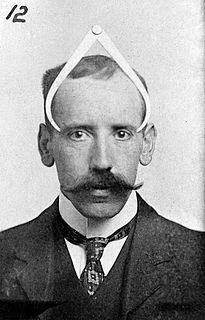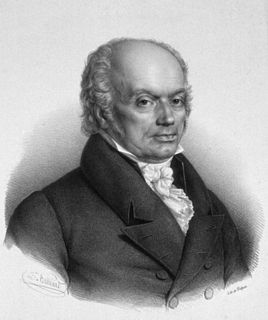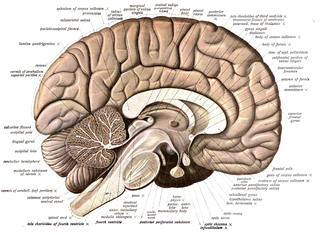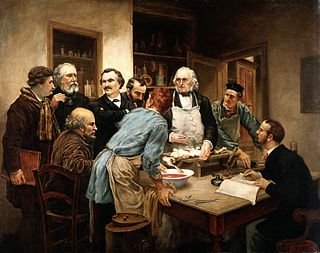
Neuroscience is the scientific study of the nervous system. It is a multidisciplinary branch of biology that combines physiology, anatomy, molecular biology, developmental biology, cytology, mathematical modeling and psychology to understand the fundamental and emergent properties of neurons and neural circuits. The understanding of the biological basis of learning, memory, behavior, perception, and consciousness has been described by Eric Kandel as the "ultimate challenge" of the biological sciences.

Phrenology is a science which involves the measurement of bumps on the skull to predict mental traits. It is based on the concept that the brain is the organ of the mind, and that certain brain areas have localized, specific functions or modules. Although both of those ideas have a basis in reality, phrenology extrapolated beyond empirical knowledge in a way that departed from science. The central phrenological notion that measuring the contour of the skull can predict personality traits is discredited by empirical research. Developed by German physician Franz Joseph Gall in 1796, the discipline was influential in the 19th century, especially from about 1810 until 1840. The principal British centre for phrenology was Edinburgh, where the Edinburgh Phrenological Society was established in 1820.
Cognitive neuroscience is the scientific field that is concerned with the study of the biological processes and aspects that underlie cognition, with a specific focus on the neural connections in the brain which are involved in mental processes. It addresses the questions of how cognitive activities are affected or controlled by neural circuits in the brain. Cognitive neuroscience is a branch of both neuroscience and psychology, overlapping with disciplines such as behavioral neuroscience, cognitive psychology, physiological psychology and affective neuroscience. Cognitive neuroscience relies upon theories in cognitive science coupled with evidence from neurobiology, and computational modeling.

The skull is a bony structure that forms the head in vertebrates. It supports the structures of the face and provides a protective cavity for the brain. The skull is composed of two parts: the cranium and the mandible. In the human, these two parts are the neurocranium and the viscerocranium or facial skeleton that includes the mandible as its largest bone. The skull forms the anterior most portion of the skeleton and is a product of cephalisation—housing the brain, and several sensory structures such as the eyes, ears, nose, and mouth. In humans these sensory structures are part of the facial skeleton.

Marie Jean Pierre Flourens, father of Gustave Flourens, was a French physiologist, the founder of experimental brain science and a pioneer in anesthesia. Through the study of ablations on animals, he was the first to prove that the mind was located in the brain, not the heart.
Neuropsychology is the study of the structure and function of the brain as they relate to specific psychological processes and behaviours. It is both an experimental and clinical field of psychology that aims to understand how behavior and cognition are influenced by brain functioning and is concerned with the diagnosis and treatment of behavioral and cognitive effects of neurological disorders. Whereas classical neurology focuses on the physiology of the nervous system and classical psychology is largely divorced from it, neuropsychology seeks to discover how the brain correlates with the mind. It thus shares concepts and concerns with neuropsychiatry and with behavioral neurology in general. The term neuropsychology has been applied to lesion studies in humans and animals. It has also been applied in efforts to record electrical activity from individual cells in higher primates. It makes use of neuroscience, and shares an information processing view of the mind with cognitive psychology and cognitive science.

Phineas P. Gage (1823–1860) was an American railroad construction foreman remembered for his improbable survival of an accident in which a large iron rod was driven completely through his head, destroying much of his brain's left frontal lobe, and for that injury's reported effects on his personality and behavior over the remaining 12 years of his life—effects sufficiently profound that friends saw him as "no longer Gage."
Modularity of mind is the notion that a mind may, at least in part, be composed of innate neural structures or modules which have distinct established evolutionarily developed functions. Somewhat different definitions of "module" have been proposed by different authors.

Craniometry is measurement of the cranium, usually the human cranium. It is a subset of cephalometry, measurement of the head, which in humans is a subset of anthropometry, measurement of the human body. It is distinct from phrenology, the pseudoscience that tried to link personality and character to head shape, and physiognomy, which tried the same for facial features. However, these fields have all claimed the ability to predict traits or intelligence.

Johann Gaspar Spurzheim was a German physician who became one of the chief proponents of phrenology, which was developed c. 1800 by Franz Joseph Gall (1758–1828).

George Combe was a Scottish lawyer and the leader and spokesman of the phrenological movement for more than twenty years. He founded the Edinburgh Phrenological Society in 1820 and was the author of the influential study The Constitution of Man (1828). Combe was trained in Scots law and had an Edinburgh solicitor's practice. After a successful marriage in 1833, Combe devoted himself in his later years to promoting phrenology internationally.

A public lecture is one means employed for educating the public in the arts and sciences. The Royal Institution has a long history of public lectures and demonstrations given by prominent experts in the field. In the 19th century, the popularity of the public lectures given by Sir Humphry Davy at the Royal Institution was so great that the volume of carriage traffic in Albemarle Street caused it to become the first one-way street in London. The Royal Institution's Christmas Lectures for young people are nowadays also shown on television. Alexander von Humboldt delivered a series of public lectures at the University of Berlin in the winter of 1827–1828, that formed the basis for his later work Kosmos.

Bernard Hollander was a London psychiatrist and one of the main proponents of the new interest in phrenology in the early 20th century.

The Edinburgh Phrenological Society was founded in 1820 by lawyer George Combe and his physician brother Andrew. The Edinburgh Society was the first and foremost phrenological grouping in Great Britain; more than forty phrenological societies followed in other parts of the British Isles. The Society's influence was greatest over the next two decades but declined in the 1840s; the final meeting was recorded in 1870.

In human neuroanatomy, brain asymmetry can refer to at least two quite distinct findings:
Luigi Ferrarese was an Italian physician and the leading proponent of phrenology in Italy in the nineteenth century.

Functional specialization suggests that different areas in the brain are specialized for different functions.
The history of anthropometry includes the use of anthropometry as an early tool of physical anthropology, use for identification, use for the purposes of understanding human physical variation, in paleoanthropology, and in various attempts to correlate physical with racial and psychological traits. At various points in history, certain anthropometrics have been cited by advocates of discrimination and eugenics, often as part of novel social movements or based upon pseudoscientific claims.

The Boston Phrenological Society was formed in 1832 upon the death of a prominent continental phrenologist, Johann Gaspar Spurzheim. Spurzheim was an anatomist and a former pupil of Franz Josef Gall. Spurzheim's brief tour and death popularized phrenology in the United States outside of its controversial place in medical lecture halls, and into the sphere of social reformers and ministers. The Society's formation launched the phrenology movement in the United States. The Boston Phrenological Society was founded by phrenology adherent Nahum Capen on the day of Spurzheim's funeral, November 17, 1832.















